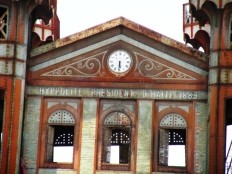Haitian All-Starz
The Best Representation of Haitian Entertainment, Culture, & LifeStyle
Haiti - Culture : Restoration of the Market Hyppolite
 |
Since March 2010, construction began on the restoration of Market Hyppolite, the north hall was demolished by fire in May 2008 and its central pavilion severely damaged by the earthquake of January 12 .
But the book by far the largest both in its size and its usefulness is, undoubtedly, that of the erection of the covered market place Valliere. For this construction, the government is for the firm Baudet & Donovan, known internationally for his reputation and cast iron construction.
The choice of iron and cast iron for the erection of these structures has its sources directly into the consequences of the Industrial Revolution in Europe.
In 1890, the engineer Alexander Bobo Haitian government receives the command did seem like the metal parts of the new market of Port-au-Prince, commanded Baudet, Donovan & Co. These pieces, carefully numbered, pre-shipment and referenced to detailed plans, arrived in port and are then transported to the site. Bobo erected the building in less than a year, "without difficulty".
The Market Plan Hyppolite has two halls strictly identical, sy-metrically placed on both sides of a central pavilion built in height, leaving the passage open to the street Traversiere. Four towers, topped with bell, placed at its corners complete the package.
Apart from foundations and the peripheral wall built of clay bricks, manufactured in France at Ivry and coverage of the central pavilion made of beautiful terra cotta tiles, the building is entirely of iron and cast iron. Its simple form is soberly decorated with elements taken from classical architecture, including the capitals of columns.
For the four towers flanking the central pavilion, Moorish style is somewhat surprising. A legend says that this market would be a station built for Cairo, Egypt.
On Sunday, November 22, 1891, the market is opened, named after its sponsor, President Hyppolite.
To increase its floor space, the city took in the 70s, the lamentable decision to build two concrete structures on the portion of the street Traversiere through the market, closing it to traffic already hampered by the stalls the market.
On the night of 29 to 30 May 2008, a fire completely destroyed the North Market Hall Hyppolite. The cast-iron columns have not withstood the high temperatures generated by fire. They gave way, carrying the roof. The stock of the damage is immense. Few castings could be recovered.
On January 12, 2010, an earthquake measuring 7.3 destroyed the concrete additions built in the 70s, damaging drop in their part of the South Hall and the main lodge, this one causing a severe loss of balance. Its foundations were already severely weakened by corrosion.
ISPAN has chosen an architectural simple: restore the hall north observing the volume, order and vocabulary building while using the metal parts of a contemporary design. The hall will be south, it was restored using the same metal parts recovered from the destroyed north hall. ISPAN and apply the letter of Article 12 of the Charter for the Conservation and Restoration of Monuments and Sites (Venice Charter, 1964) which advocates that "the elements to replace the missing parts must integrate smooth-ing at all, while differing from the original so that restoration does not falsify the art and history. "
The site started by cleaning the site of the north hall and the inventory of recoverable metal. Meanwhile, the construction team has made the demolition of historic structures not recently added to the mix.
She proceeded to stabilize the central pavilion, a necessary step for removal thereof. This operation was to sink huge blocks of concrete coarse at the base of the turrets, acting as a counterweight. These blocks will be demolished later.
From May 24 to 26, using a crane, we proceeded with the removal of the turrets that were cut with a torch and then placed on the ground on concrete bases. After full restoration and identical operation to roll-die shop, they will be relocated to their original position.
In the months that followed, according to the chrono-gram established by operators of construction, the central pavilion will be completely disassembled to be restored, the painting will be removed by sand blasting (sandblasting). Then, follow the assembly of the central pavilion, installation of the new structure of the north hall, the restoration of the south hall and finishing work.
According to the timetable, the restoration should end December 12, 2010. The inauguration ceremony is scheduled for January 12, 2011.
This date should give the symbolic start of the rehabilitation of the city of Port-au-Prince, which was destroyed by the earthquake of January 12, 2010.
Article By HL/ HaïtiLibre
Social Network
All-StarZ TV
Events
Birthdays
Birthdays Tomorrow
© 2025 Created by Haitian All-Starz.
Powered by
![]()
 Haitian Gourde Converter
Haitian Gourde Converter



You need to be a member of Haitian All-Starz to add comments!
Join Haitian All-Starz